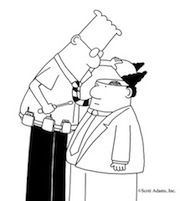 The Peter Principle (Dr. Laurence J. Peter’s and Raymond Hull’s 1969 book, “The Peter Principle: Why Things Always Go Wrong”), states that excellent doers are promoted and promoted, doing less and less real work at each new level until they finally reach their level of incompetence.
The Peter Principle (Dr. Laurence J. Peter’s and Raymond Hull’s 1969 book, “The Peter Principle: Why Things Always Go Wrong”), states that excellent doers are promoted and promoted, doing less and less real work at each new level until they finally reach their level of incompetence.
The Reverse Peter Principle states that organizations should strive to stay as flat as possible and every manager should stay as close to the front line and DO as much as possible.
The best people understand their jobs, the meaning and underlying purpose of their tasks and only need to be pointed in the right direction, apprised of available resources, given guidelines, goals, targets, deadlines, and intermediate check in points. People who are doing what they love and understand need relatively little management.
When an organization’s best people spend too much time managing and not enough time DOING, then it may be time to spend more effort on raising the performance bar in other ways: recruiting at a higher level and providing better, more-focused training.
Closing quotes:
“If you can’t change the people, change the people.” — Jack Welch
NOTE: I’m indebted to Tracy Dolgin, CEO of YES cable sports network, for the Reverse Peter Principle concept.


0 Comments